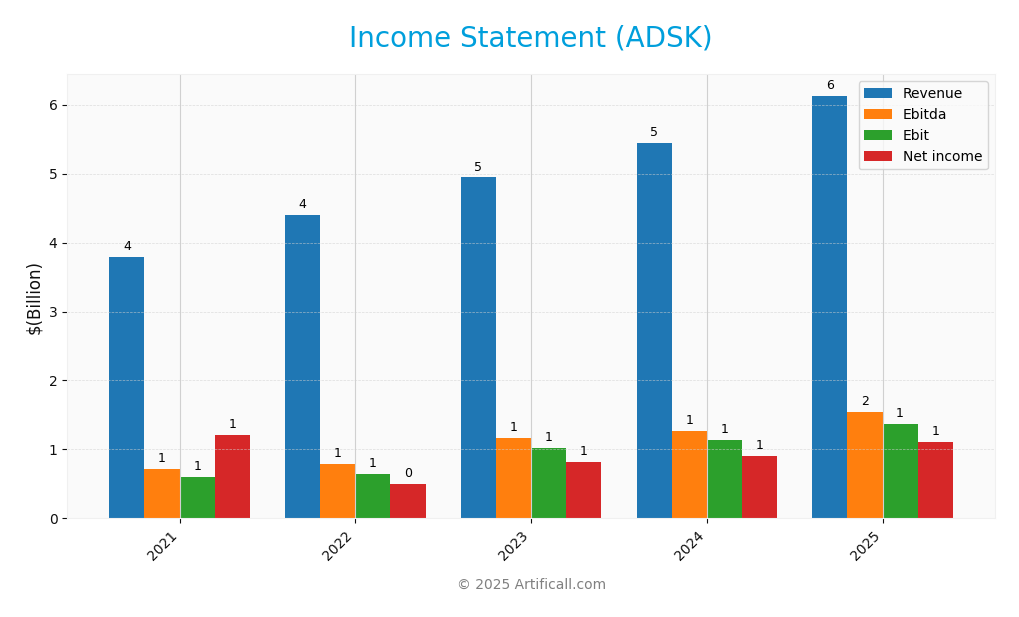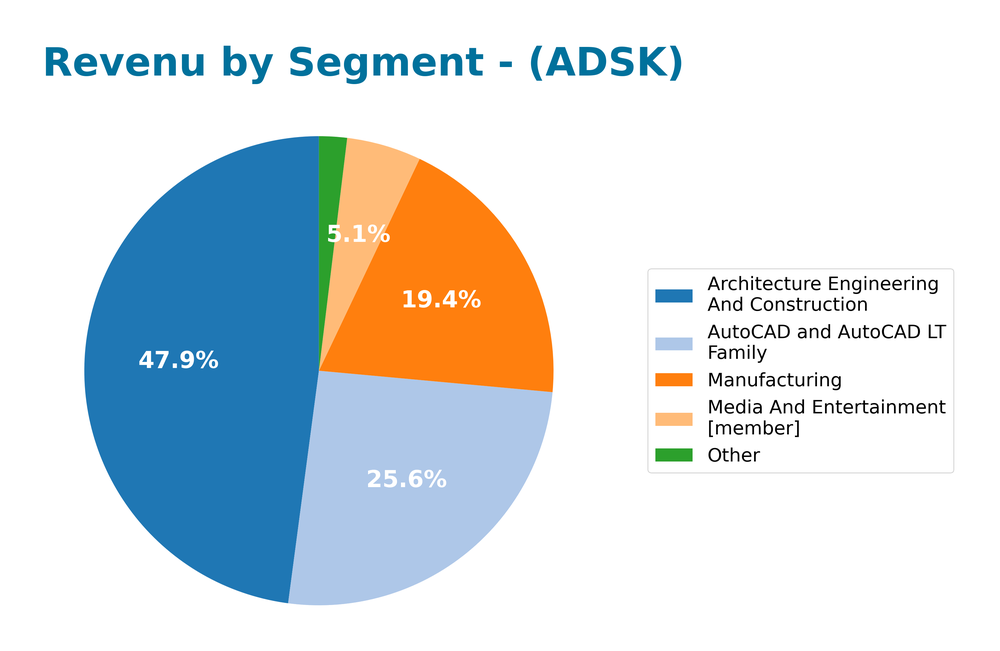In a world increasingly reliant on advanced design and engineering solutions, Autodesk, Inc. plays a pivotal role by transforming how industries visualize and execute projects. Renowned for its innovative software suite—including flagship products like AutoCAD and Fusion 360—Autodesk empowers professionals across architecture, engineering, and entertainment to unlock their creative potential and streamline their workflows. As we delve into Autodesk’s current market position, we must ask: do its robust fundamentals still justify the current valuation, and what does the future hold for this tech giant?

Table of contents
Company Description
Autodesk, Inc. (NASDAQ: ADSK), founded in 1982 and headquartered in San Rafael, California, is a prominent player in the software application industry, specializing in 3D design, engineering, and entertainment software. With a market capitalization of approximately $64.2B, Autodesk offers a diverse range of products, including AutoCAD, BIM 360, and Fusion 360, catering to sectors such as architecture, engineering, construction, and manufacturing. Operating globally, the company employs around 15,300 individuals and provides services directly and through resellers. As a leader in innovation, Autodesk is pivotal in shaping digital workflows and enhancing collaboration across industries, solidifying its role in driving technological advancements.
Fundamental Analysis
In this section, I will analyze Autodesk, Inc.’s income statement, financial ratios, and dividend payout policy to assess its financial health and investment potential.
Income Statement
The following table presents a comprehensive overview of Autodesk, Inc.’s financial performance over the past five fiscal years, showcasing key metrics such as revenue, net income, and earnings per share (EPS).

| Metric | 2021 | 2022 | 2023 | 2024 | 2025 |
|---|---|---|---|---|---|
| Revenue | 3.79B | 4.40B | 4.95B | 5.44B | 6.13B |
| Cost of Revenue | 0.37B | 0.46B | 0.52B | 0.55B | 0.58B |
| Operating Expenses | 2.78B | 3.28B | 3.44B | 3.77B | 4.20B |
| Gross Profit | 3.42B | 3.94B | 4.43B | 4.89B | 5.55B |
| EBITDA | 0.72B | 0.79B | 1.17B | 1.27B | 1.55B |
| EBIT | 0.60B | 0.64B | 1.02B | 1.14B | 1.37B |
| Interest Expense | 0.05B | 0.08B | 0.07B | 0.00B | 0.00B |
| Net Income | 1.21B | 0.50B | 0.82B | 0.91B | 1.11B |
| EPS | 5.51 | 2.26 | 3.81 | 4.19 | 5.17 |
| Filing Date | 2021-03-19 | 2022-03-14 | 2023-03-14 | 2024-06-10 | 2025-03-06 |
Over the past five years, Autodesk has shown a consistent upward trajectory in revenue, growing from 3.79B in 2021 to 6.13B in 2025. This 61% increase reflects a strong demand for its products and services. However, net income exhibited more volatility, rising significantly to 1.21B in 2021 before experiencing a dip in 2022, followed by a steady recovery to 1.11B in 2025. The gross profit margin has remained relatively stable, indicating effective cost management despite rising operating expenses. In the most recent year, while revenue growth continued, net income growth was more modest, suggesting that while Autodesk is successfully expanding its top line, it faces increasing operational costs that could impact future profitability.
Financial Ratios
The following table presents the financial ratios for Autodesk, Inc. (ADSK) over the last available years.
| Financial Ratios | 2021 | 2022 | 2023 | 2024 | 2025 |
|---|---|---|---|---|---|
| Net Margin | 31.87% | 11.30% | 16.64% | 16.65% | 18.14% |
| ROE | 33.75% | 28.03% | 25.86% | 22.23% | 15.45% |
| ROIC | 21.92% | 10.45% | 13.82% | 12.62% | 14.45% |
| P/E | 52.00 | 110.42 | 56.47 | 60.51 | 60.20 |
| P/B | 65.06 | 64.63 | 40.59 | 29.55 | 25.54 |
| Current Ratio | 0.83 | 0.69 | 0.84 | 0.82 | 0.68 |
| Quick Ratio | 0.83 | 0.69 | 0.84 | 0.82 | 0.68 |
| D/E | 2.18 | 3.61 | 2.33 | 1.42 | 0.98 |
| Debt-to-Assets | 28.91% | 35.55% | 28.25% | 26.49% | 23.62% |
| Interest Coverage | 12.71 | 8.67 | 13.97 | 0.00 | 0.00 |
| Asset Turnover | 0.52 | 0.51 | 0.52 | 0.55 | 0.57 |
| Fixed Asset Turnover | 6.22 | 9.42 | 12.71 | 15.77 | 21.44 |
| Dividend Yield | 0.00% | 0.00% | 0.00% | 0.00% | 0.00% |
Interpretation of Financial Ratios
For the fiscal year 2025, Autodesk’s net margin of 18.14% indicates a strong profitability level, though its ROE at 15.45% suggests a declining return on equity compared to prior years. The P/E ratio of 60.20 points to high market expectations but also raises concerns about overvaluation. The current ratio of 0.68 highlights potential liquidity issues, which should be monitored closely.
Evolution of Financial Ratios
Over the past five years, Autodesk’s financial ratios exhibit a mixed trend. While net margins and asset turnover have improved, the significant fluctuations in P/E and D/E ratios raise concerns regarding valuation and debt management. The increase in fixed asset turnover suggests greater efficiency in utilizing assets, but liquidity ratios indicate potential challenges that need addressing.
Distribution Policy
Autodesk, Inc. does not pay dividends, opting instead to reinvest earnings into growth opportunities and research & development. This strategy aligns with its high growth phase, allowing for potential long-term value creation for shareholders. Furthermore, Autodesk engages in share buybacks, which can enhance shareholder value by reducing outstanding shares. Overall, this approach appears to support sustainable growth, although it carries inherent risks related to market volatility and the execution of its growth strategies.
Sector Analysis
Autodesk, Inc. operates in the Software – Application industry, specializing in 3D design and engineering solutions. Key competitors include Adobe and Dassault Systèmes, while Autodesk’s competitive advantages lie in its robust product offerings and market recognition.
Strategic Positioning
Autodesk, Inc. (ADSK) holds a significant market share in the software application industry, particularly recognized for its 3D design and engineering solutions. With a current market cap of approximately 64.2B, Autodesk faces competitive pressure from both established players and emerging technologies that threaten traditional software models. The rapid advancement in cloud-based solutions and AI integration poses a potential disruption to its traditional offerings. However, Autodesk’s strong portfolio, including products like AutoCAD and BIM 360, positions it favorably against competitors, allowing it to maintain a leadership role in innovative design solutions.
Revenue by Segment
The following pie chart illustrates Autodesk, Inc.’s revenue distribution across different segments for the fiscal year 2025.

In 2025, Autodesk’s revenue saw significant contributions from key segments: Architecture Engineering and Construction (3B), AutoCAD and AutoCAD LT Family (1.57B), and Manufacturing (1.19B). The Architecture segment continues to be the primary driver, growing from 2.58B in 2024, indicating a robust demand. However, the Media and Entertainment segment, while stable at 315M, has shown slower growth relative to others. Overall, the recent year’s performance reflects a solid upward trajectory, though I remain cautious about potential margin pressures in the face of rising operational costs.
Key Products
Below is a table outlining the key products offered by Autodesk, Inc., which play a crucial role in various industries such as architecture, engineering, and entertainment.
| Product | Description |
|---|---|
| AutoCAD | A professional design and drafting software that facilitates detailed design, visualization, and documentation. |
| BIM 360 | A cloud-based construction management software that enhances collaboration and efficiency throughout the construction lifecycle. |
| Fusion 360 | An integrated 3D CAD, CAM, and CAE tool that supports product design and manufacturing processes. |
| Inventor | A software suite for 3D mechanical design, simulation, and documentation that helps in creating complex assemblies. |
| Vault | A data management solution that centralizes design data, streamlining collaboration and accelerating design processes. |
| Maya | A comprehensive 3D modeling, animation, and visual effects software used extensively in film and video game production. |
| 3ds Max | A powerful 3D modeling, animation, and rendering software that is widely used in visual effects, games, and architecture. |
| ShotGrid | A cloud-based software for production tracking and review in the media and entertainment industry, enhancing project management. |
These products are pivotal in helping professionals create and manage their designs effectively across various sectors.
Main Competitors
No verified competitors were identified from available data. Autodesk, Inc. has an estimated market share of approximately 10% in the software application industry, particularly in 3D design and engineering software. The company holds a strong competitive position, primarily serving sectors such as architecture, engineering, construction, and manufacturing, making it a dominant player within its niche market.
Competitive Advantages
Autodesk, Inc. (ADSK) boasts a strong competitive advantage through its comprehensive suite of software solutions tailored for various industries, including architecture, engineering, and entertainment. Their leading products, such as AutoCAD and BIM 360, are well-established in the market, providing customers with innovative tools to enhance productivity and collaboration. Looking ahead, Autodesk is poised to capitalize on emerging trends in artificial intelligence and cloud computing, with plans to introduce new features and expand into untapped markets. This positions the company favorably for sustained growth and increased market share in the dynamic software industry.
SWOT Analysis
The following SWOT analysis provides insights into Autodesk, Inc.’s current position and strategic outlook.
Strengths
- Strong brand recognition
- Diverse product portfolio
- Innovative software solutions
Weaknesses
- High dependency on specific markets
- Limited dividend history
- High competition in the software sector
Opportunities
- Growing demand for cloud-based solutions
- Expansion into emerging markets
- Increasing adoption of 3D design technologies
Threats
- Economic downturn impacts spending
- Rapid technological advancements by competitors
- Regulatory challenges in software usage
Overall, Autodesk’s strengths in brand and innovation position it well for future growth, while weaknesses and external threats necessitate strategic risk management. The company should leverage emerging opportunities to enhance its market share while addressing potential vulnerabilities.
Stock Analysis
Over the past year, Autodesk, Inc. (ADSK) has demonstrated significant price movements, with a notable bullish trend primarily driven by robust market dynamics. The stock has experienced fluctuating trading volumes, which highlight the ongoing investor interest and sentiment.

Trend Analysis
Analyzing the price trend over the past year, Autodesk’s stock has shown a percentage change of +23.33%, indicating a bullish trend. However, in the recent period from August 31, 2025, to November 16, 2025, the stock has experienced a decline of -4.86%. This recent movement suggests a deceleration in momentum, with a standard deviation of 9.91 reflecting moderate volatility. The highest price during this timeframe reached 326.37, while the lowest was 201.6, reinforcing the stock’s ability to maintain a generally upward trajectory despite recent challenges.
Volume Analysis
In examining the trading volumes over the last three months, the average volume stands at approximately 7.18M shares, with a buyer-driven activity noted as the average buy volume (4.46M) surpasses the average sell volume (2.72M). This suggests a prevailing positive sentiment among investors, even though the overall volume trend is bearish, as indicated by a declining trend slope of -458.22. The buyer volume proportion remains strong at 62.17%, signaling that while there may be recent selling pressures, buyers are actively participating in the market.
Analyst Opinions
Recent analyst recommendations for Autodesk, Inc. (ADSK) show a consensus to “buy.” Analysts highlight the company’s strong return on equity (5) and return on assets (5), indicating robust operational efficiency. The discounted cash flow score (3) further supports growth potential. Notable analysts, including those from major investment firms, emphasize Autodesk’s solid financial health, despite a lower score in price-to-earnings (1) and price-to-book (1). Overall, the sentiment leans positively towards Autodesk, making it a potentially attractive addition to investment portfolios for this year.
Stock Grades
Autodesk, Inc. (ADSK) has received consistent evaluations from multiple reputable grading companies, indicating a stable outlook among analysts.
| Grading Company | Action | New Grade | Date |
|---|---|---|---|
| Citigroup | Maintain | Buy | 2025-11-14 |
| RBC Capital | Maintain | Outperform | 2025-10-06 |
| HSBC | Upgrade | Buy | 2025-10-01 |
| Morgan Stanley | Maintain | Overweight | 2025-09-02 |
| Citigroup | Maintain | Buy | 2025-09-02 |
| RBC Capital | Maintain | Outperform | 2025-08-29 |
| Barclays | Maintain | Overweight | 2025-08-29 |
| Baird | Maintain | Outperform | 2025-08-29 |
| UBS | Maintain | Buy | 2025-08-29 |
| Mizuho | Maintain | Outperform | 2025-08-29 |
Overall, the trend in grades for Autodesk shows a preference for “Buy” and “Outperform,” with several analysts maintaining their positive outlook. Notably, HSBC recently upgraded its grade to “Buy,” suggesting growing confidence in Autodesk’s performance.
Target Prices
The consensus target prices for Autodesk, Inc. (ADSK) reflect a positive outlook from analysts.
| Target High | Target Low | Consensus |
|---|---|---|
| 385 | 305 | 365.47 |
Overall, analysts expect Autodesk’s stock to reach a consensus price of approximately 365.47, indicating a favorable sentiment in the market.
Consumer Opinions
Consumer sentiment towards Autodesk, Inc. reflects a blend of appreciation for its innovative tools and frustration over pricing structures.
| Positive Reviews | Negative Reviews |
|---|---|
| “Autodesk’s software revolutionized our design process!” | “The subscription costs are too high for small businesses.” |
| “Excellent customer support and resources.” | “Frequent updates can be disruptive.” |
| “User-friendly interface that boosts productivity.” | “Some features feel outdated and need improvements.” |
Overall, consumer feedback highlights Autodesk’s strong innovation and support, while concerns about pricing and update management persist.
Risk Analysis
In this section, I will outline the key risks associated with Autodesk, Inc. (ADSK) that every investor should consider.
| Category | Description | Probability | Impact |
|---|---|---|---|
| Market Volatility | Fluctuations in demand for design software. | High | High |
| Cybersecurity | Potential data breaches affecting user information. | Medium | High |
| Regulatory Changes | New regulations impacting software development. | Medium | Medium |
| Competition | Increasing competition from emerging tech firms. | High | Medium |
| Economic Downturn | Global economic slowdowns affecting customer budgets. | Medium | High |
Among these risks, market volatility and cybersecurity threats stand out as the most likely and impactful, especially given the rapid evolution of technology and increasing cyber threats in recent years.
Should You Buy Autodesk, Inc.?
Autodesk, Inc. (ADSK) showcases strong financial health with a net margin of 18.14%, a return on invested capital (ROIC) of 13.0%, and a weighted average cost of capital (WACC) of 10.42%. The company benefits from its flagship products in design software and a competitive advantage through its subscription-based revenue model. However, recent risks include increased competition and potential supply chain challenges.
Based on the current net margin and the favorable ROIC relative to WACC, alongside a positive long-term trend and strong buyer volumes, Autodesk appears favorable for long-term investors. The stock could serve as a solid addition to a long-term portfolio strategy, although I would remain vigilant regarding market conditions.
It’s worth noting that Autodesk faces ongoing risks from competition and market dependence, which could impact future performance.
Disclaimer: This article is not financial advice. Each investor is responsible for their own investment decisions.
Additional Resources
- Sustainable Growth Advisers LP Sells 728,680 Shares of Autodesk, Inc. $ADSK – MarketBeat (Nov 16, 2025)
- Massachusetts Financial Services Co. MA Sells 19,884 Shares of Autodesk, Inc. $ADSK – MarketBeat (Nov 16, 2025)
- Autodesk, Inc. $ADSK Shares Bought by PNC Financial Services Group Inc. – MarketBeat (Nov 16, 2025)
- Autodesk, Inc. $ADSK Stock Position Lifted by Fiera Capital Corp – MarketBeat (Nov 15, 2025)
- KBC Group NV Raises Position in Autodesk, Inc. $ADSK – MarketBeat (Nov 14, 2025)
For more information about Autodesk, Inc., please visit the official website: autodesk.com



